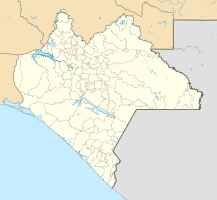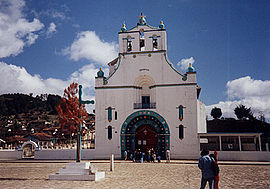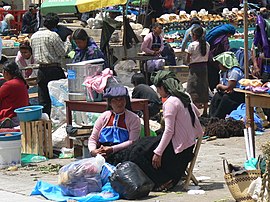Chamula
| Chamula | ||
|---|---|---|
|
Coordinates: 16 ° 47 ' N , 92 ° 41' W Chamula on the map of Chiapas
|
||
| Basic data | ||
| Country | Mexico | |
| State | Chiapas | |
| Municipio | Chamula | |
| City foundation | 1524 | |
| Residents | 3329 (2010) | |
| City insignia | ||
| Detailed data | ||
| height | 2260 m | |
| prefix | 967 | |
| New church in Chamula | ||
| Procession in Chamula, the cultural center of the Tzotzil | ||
| Chamula - market | ||
Chamula (also San Juan Chamula ) is a place in the Mexican state of Chiapas and is located in the center of the state near the city of San Cristóbal de las Casas . Chamula is the administrative seat of the Municipio Chamula and with around 3,300 inhabitants it is also the largest town in the Municipio.
Chamula lies at 2,260 m above sea level. d. M.
economy
The main economic activities are subsistence farming and, more recently, the making of handicrafts for sale to tourists.
Tzotzil culture
The inhabitants of Chamula belong to the Tzotzil people (indigenous people and descendants of the Maya ). Almost all of them speak the indigenous Tzotzil language and very many do not speak Spanish. According to the 2010 census, 69,475 out of 69,796 people aged 3 and over in the municipality, i.e. 99.54%, spoke the indigenous language. 41,736 people, or 59.80%, did not speak Spanish. Of all 15,853 children aged 3 to 9 in Chamula, 15,699 or 99.03% spoke their indigenous language, 14,242 of these children or 89.84% did not speak Spanish.
The Tzotzil of Chamula are known to strictly defend their traditional culture and religion against external influences. B. Converts due to frequent missionary activities of Jehovah's Witnesses must leave the community. Their syncretistic belief includes both the worship of Christian saints and traditional rituals, such as B. Diseases are to be cured. A shaman invokes harmful spirits ( demons ) by belching , which, according to the Indians, have attacked a sick person by driving into a living chicken, which is then killed. These ceremonies take place daily in the Catholic parish church , which is dedicated to the patron saint John the Baptist . Traditionally, a homemade sugar cane schnapps called Posch is drunk. More recently, carbonated lemonades such as Coca-Cola, Sprite and Fanta have also been used in these ceremonies, making burping easier for the shaman.
The church is one of the few surviving examples of the traditional church interiors of the indigenous people. There are no pews, the floor is covered with pine needles and brushwood , and private ceremonies take place in various places. Tourists were free to visit the church at the beginning of the 1990s, but today for an entrance fee. There is a strict, monitored ban on photography in the interior, especially to protect the participants in the private ceremonies.
Chamula and the indigenous revolution
In 1867, as a result of the suppression of a religious movement, an indigenous rebellion started in the village of Chamula, which could not be put down until 1870.
The victorious indigenous revolution initiated by the EZLN guerrilla movement in 1994 also began in Chamula. Since then, Chamula has been managed autonomously.
On July 23, 2016, Mayor Domingo López González (and one of his companions) was shot dead by strangers. He had spoken to demonstrators.
literature
- B. Traven : Land of Spring , Gutenberg Book Guild Typesetting and printing by Buchdruckwerkstätte GmbH, Berlin, published in 1928.
Web links
swell
- ^ INEGI 2010: Censo de Población y Vievienda 2010 , accessed on March 25, 2011
- ^ B. Traven : Land des Frühling Buchgilde Gutenberg typesetting and printing of the Buchdruckwerkstätte GmbH, Berlin, published 1928.
- ↑ http://orf.at/#/stories/2350899/ During protests: Mayor shot in Mexico, orf.at, July 23, 2016, accessed July 23, 2016.






